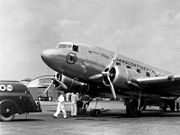
TWA Flight 3
Encyclopedia
TWA Flight 3 was a twin-engine Douglas DC-3-382
propliner
, registration NC1946, operated by Transcontinental and Western Air
as a scheduled domestic passenger flight from New York, New York
, to Burbank, California
, via Indianapolis
, Indiana; St. Louis, Missouri
; Albuquerque, New Mexico
and Las Vegas, Nevada
. On January 16, 1942, at 19:20 PST
, 15 minutes after takeoff from Las Vegas Airport (now Nellis Air Force Base
) bound for Burbank, the aircraft slammed into a sheer cliff on Potosi Mountain
, 32 miles southwest of the airport, at an elevation of 7,770 ft above sea level
, and was destroyed.
All nineteen passengers on board, including movie star Carole Lombard
and her mother, and all three crew members, died in the crash.
The Civil Aeronautics Board (CAB) investigated the accident and determined it was caused by a navigation error by the captain
.
 TWA Flight 3 was flying a transcontinental route from New York to greater Los Angeles with multiple intermediate stops, including Indianapolis, Saint Louis, and Albuquerque, with a final destination at Burbank, California.
TWA Flight 3 was flying a transcontinental route from New York to greater Los Angeles with multiple intermediate stops, including Indianapolis, Saint Louis, and Albuquerque, with a final destination at Burbank, California.
At 4:00 local time on the morning of January 16, in Indianapolis, Indiana, Carole Lombard, her mother Elizabeth Knight, and her MGM
press agent Otto Winkler, boarded Flight 3 to return to California. Lombard, anxious to meet her husband Clark Gable
in Los Angeles, was returning from a successful War Bonds promotion tour in the Midwest, where she helped raise over $2,000,000. (She would become the first female casualty of the U.S. war effort in World War II
.)
 Upon arrival in Albuquerque, Lombard and her companions were asked to give up their seats for the continuing flight segment, to make room for 15 U.S. Army Air Corps personnel flying to California. Lombard insisted that because of her War Bonds effort, she too was essential, and convinced the station agent to let her group re-board the flight. Other passengers were removed instead, including violinist Joseph Szigeti
Upon arrival in Albuquerque, Lombard and her companions were asked to give up their seats for the continuing flight segment, to make room for 15 U.S. Army Air Corps personnel flying to California. Lombard insisted that because of her War Bonds effort, she too was essential, and convinced the station agent to let her group re-board the flight. Other passengers were removed instead, including violinist Joseph Szigeti
.
The original flight crew was replaced with a new one at Albuquerque. Although a refueling stop had been planned in Winslow, Arizona
, because of the higher loads and forecast headwinds, the captain decided to skip the Winslow stop while en route and proceeded directly to Las Vegas.
After a brief refueling stop at what is now Nellis Air Force Base
in Las Vegas, the plane took off on a clear night for its final leg to Burbank. Fifteen minutes later, flying almost seven miles off course, it crashed into a near vertical cliff on Potosi Mountain
in the Spring Mountain range
at 7,770 ft, about 80 ft below the top of the cliff and 730 ft below the summit, killing all on board.
, into high terrain that rose above their flight altitude of 8,000 ft. This indicated to investigators that the crew were not using radio navigation
to follow the airway (defined by the low frequency range
), which would have provided them safe obstacle clearance, but were instead using a compass heading.
Visibility was generally good, but since most airway light beacons
had been turned off
because of the war, they were not usable, although one important beacon was in fact operating normally.
A key piece of evidence was the flight plan form, completed by the first officer in Albuquerque (but not signed by the captain, despite a company requirement to do so). In the form, the planned outbound magnetic course from Las Vegas was filled out as 218°, which is close to the flight path actually flown by the crew to the crash point. Since this course, flown at 8,000 ft, is lower than the terrain in that direction (which rises to about 8,500 ft), the board concluded it was clearly an error. The board speculated that since both pilots had flown to Burbank much more frequently from Boulder Airport (BLD) than from Las Vegas, and that from Boulder Airport an outbound magnetic course of 218° would have been a reasonable choice to join the airway to Burbank, it was likely that the crew inadvertently used the Boulder outbound course instead of the appropriate Las Vegas course. To test their hypothesis, the CAB asked to review some other completed TWA flight plan forms for flights between Albuquerque and Las Vegas. Surprisingly, they discovered another form, of an actual flight, which also specified the same incorrect 218° outbound course from Las Vegas as the accident flight. TWA's chief pilot testified that the course filled out on that form was "obviously a mistake."
The CAB issued a final report with the following probable cause statement:(if link above fails to load report, visit http://dotlibrary.specialcollection.net and select "Historical Aircraft Accident Reports (1934-1965)", then retry report link)
The CAB added the following contributing factors:
Douglas DC-3
The Douglas DC-3 is an American fixed-wing propeller-driven aircraft whose speed and range revolutionized air transport in the 1930s and 1940s. Its lasting impact on the airline industry and World War II makes it one of the most significant transport aircraft ever made...
propliner
Propliner
A propliner is a large, propeller-driven airliner. Typically, the term is used for piston-powered airliners that flew before the beginning of the jet age, not for modern turbine-powered propeller airliners...
, registration NC1946, operated by Transcontinental and Western Air
Trans World Airlines
Trans World Airlines was an American airline that existed from 1925 until it was bought out by and merged with American Airlines in 2001. It was a major domestic airline in the United States and the main U.S.-based competitor of Pan American World Airways on intercontinental routes from 1946...
as a scheduled domestic passenger flight from New York, New York
New York City
New York is the most populous city in the United States and the center of the New York Metropolitan Area, one of the most populous metropolitan areas in the world. New York exerts a significant impact upon global commerce, finance, media, art, fashion, research, technology, education, and...
, to Burbank, California
Burbank, California
Burbank is a city in Los Angeles County in Southern California, United States, north of downtown Los Angeles. The estimated population in 2010 was 103,340....
, via Indianapolis
Indianapolis
Indianapolis is the capital of the U.S. state of Indiana, and the county seat of Marion County, Indiana. As of the 2010 United States Census, the city's population is 839,489. It is by far Indiana's largest city and, as of the 2010 U.S...
, Indiana; St. Louis, Missouri
St. Louis, Missouri
St. Louis is an independent city on the eastern border of Missouri, United States. With a population of 319,294, it was the 58th-largest U.S. city at the 2010 U.S. Census. The Greater St...
; Albuquerque, New Mexico
Albuquerque, New Mexico
Albuquerque is the largest city in the state of New Mexico, United States. It is the county seat of Bernalillo County and is situated in the central part of the state, straddling the Rio Grande. The city population was 545,852 as of the 2010 Census and ranks as the 32nd-largest city in the U.S. As...
and Las Vegas, Nevada
Las Vegas, Nevada
Las Vegas is the most populous city in the U.S. state of Nevada and is also the county seat of Clark County, Nevada. Las Vegas is an internationally renowned major resort city for gambling, shopping, and fine dining. The city bills itself as The Entertainment Capital of the World, and is famous...
. On January 16, 1942, at 19:20 PST
Pacific Time Zone
The Pacific Time Zone observes standard time by subtracting eight hours from Coordinated Universal Time . The clock time in this zone is based on the mean solar time of the 120th meridian west of the Greenwich Observatory. During daylight saving time, its time offset is UTC-7.In the United States...
, 15 minutes after takeoff from Las Vegas Airport (now Nellis Air Force Base
Nellis Air Force Base
Nellis Air Force Base is a United States Air Force Base, located approximately northeast of Las Vegas, Nevada. It is under the jurisdiction of Air Combat Command .-Overview:...
) bound for Burbank, the aircraft slammed into a sheer cliff on Potosi Mountain
Potosi Mountain
Potosi Mountain, located in Clark County, Nevada, is one of the six high points surrounding Las Vegas. Potosi Mountain is about southwest of Las Vegas in the Spring Mountains, in Clark County of southern Nevada....
, 32 miles southwest of the airport, at an elevation of 7,770 ft above sea level
Above mean sea level
The term above mean sea level refers to the elevation or altitude of any object, relative to the average sea level datum. AMSL is used extensively in radio by engineers to determine the coverage area a station will be able to reach...
, and was destroyed.
All nineteen passengers on board, including movie star Carole Lombard
Carole Lombard
Carole Lombard was an American actress. She was particularly noted for her comedic roles in the screwball comedies of the 1930s...
and her mother, and all three crew members, died in the crash.
The Civil Aeronautics Board (CAB) investigated the accident and determined it was caused by a navigation error by the captain
Pilot in command
The pilot in command of an aircraft is the person aboard the aircraft who is ultimately responsible for its operation and safety during flight. This would be the "captain" in a typical two- or three-pilot flight crew, or "pilot" if there is only one certified and qualified pilot at the controls of...
.
Flight history

At 4:00 local time on the morning of January 16, in Indianapolis, Indiana, Carole Lombard, her mother Elizabeth Knight, and her MGM
Metro-Goldwyn-Mayer
Metro-Goldwyn-Mayer Inc. is an American media company, involved primarily in the production and distribution of films and television programs. MGM was founded in 1924 when the entertainment entrepreneur Marcus Loew gained control of Metro Pictures, Goldwyn Pictures Corporation and Louis B. Mayer...
press agent Otto Winkler, boarded Flight 3 to return to California. Lombard, anxious to meet her husband Clark Gable
Clark Gable
William Clark Gable , known as Clark Gable, was an American film actor most famous for his role as Rhett Butler in the 1939 Civil War epic film Gone with the Wind, in which he starred with Vivien Leigh...
in Los Angeles, was returning from a successful War Bonds promotion tour in the Midwest, where she helped raise over $2,000,000. (She would become the first female casualty of the U.S. war effort in World War II
World War II
World War II, or the Second World War , was a global conflict lasting from 1939 to 1945, involving most of the world's nations—including all of the great powers—eventually forming two opposing military alliances: the Allies and the Axis...
.)

Joseph Szigeti
Joseph Szigeti was a Hungarian violinist.Born into a musical family, he spent his early childhood in a small town in Transylvania. He quickly proved himself to be a child prodigy on the violin, and moved to Budapest with his father to study with the renowned pedagogue Jenő Hubay...
.
The original flight crew was replaced with a new one at Albuquerque. Although a refueling stop had been planned in Winslow, Arizona
Winslow, Arizona
-Demographics:As of the census of 2000, there were 9,520 people, 2,754 households, and 1,991 families residing in the city. The population density was 773.1 people per square mile . There were 3,198 housing units at an average density of 259.7 per square mile...
, because of the higher loads and forecast headwinds, the captain decided to skip the Winslow stop while en route and proceeded directly to Las Vegas.
After a brief refueling stop at what is now Nellis Air Force Base
Nellis Air Force Base
Nellis Air Force Base is a United States Air Force Base, located approximately northeast of Las Vegas, Nevada. It is under the jurisdiction of Air Combat Command .-Overview:...
in Las Vegas, the plane took off on a clear night for its final leg to Burbank. Fifteen minutes later, flying almost seven miles off course, it crashed into a near vertical cliff on Potosi Mountain
Potosi Mountain
Potosi Mountain, located in Clark County, Nevada, is one of the six high points surrounding Las Vegas. Potosi Mountain is about southwest of Las Vegas in the Spring Mountains, in Clark County of southern Nevada....
in the Spring Mountain range
Spring Mountains
The Spring Mountains are a mountain range of southern Nevada in the United States, running generally northwest-southeast along the west side of Las Vegas and down to the border with California...
at 7,770 ft, about 80 ft below the top of the cliff and 730 ft below the summit, killing all on board.
Investigation
The accident was investigated by the Civil Aeronautics Board. Eyewitness and other evidence suggested Flight 3 proceeded from its departure in Las Vegas along essentially a straight line, 10° right of the designated airwayAirway (aviation)
In aviation, an airway is a designated route in the air. Airways are laid out between navigational aids such as VORs, NDBs and Intersections ....
, into high terrain that rose above their flight altitude of 8,000 ft. This indicated to investigators that the crew were not using radio navigation
Radio navigation
Radio navigation or radionavigation is the application of radio frequencies to determine a position on the Earth. Like radiolocation, it is a type of radiodetermination.The basic principles are measurements from/to electric beacons, especially...
to follow the airway (defined by the low frequency range
Low Frequency radio range
The low-frequency radio range , also known as the four-course radio range, LF/MF four-course radio range, A-N radio range, Adcock radio range, or commonly "the range", was the main navigation system used by aircraft for instrument flying in the 1930s and 1940s, until the advent of the VHF...
), which would have provided them safe obstacle clearance, but were instead using a compass heading.
Visibility was generally good, but since most airway light beacons
Airway Beacon
An Airway beacon was a rotating light on a tower used for visual navigation by airplane pilots along a specified airway corridor. Approximately 1,500 Airway beacons were constructed, covering 18,000 miles in the U.S. to guide pilots from city to city. Construction by the Post Office and...
had been turned off
Blackout (wartime)
A blackout during war, or apprehended war, is the practice of collectively minimizing outdoor light, including upwardly directed light. This was done in the 20th century to prevent crews of enemy aircraft from being able to navigate to their targets simply by sight, for example during the London...
because of the war, they were not usable, although one important beacon was in fact operating normally.
A key piece of evidence was the flight plan form, completed by the first officer in Albuquerque (but not signed by the captain, despite a company requirement to do so). In the form, the planned outbound magnetic course from Las Vegas was filled out as 218°, which is close to the flight path actually flown by the crew to the crash point. Since this course, flown at 8,000 ft, is lower than the terrain in that direction (which rises to about 8,500 ft), the board concluded it was clearly an error. The board speculated that since both pilots had flown to Burbank much more frequently from Boulder Airport (BLD) than from Las Vegas, and that from Boulder Airport an outbound magnetic course of 218° would have been a reasonable choice to join the airway to Burbank, it was likely that the crew inadvertently used the Boulder outbound course instead of the appropriate Las Vegas course. To test their hypothesis, the CAB asked to review some other completed TWA flight plan forms for flights between Albuquerque and Las Vegas. Surprisingly, they discovered another form, of an actual flight, which also specified the same incorrect 218° outbound course from Las Vegas as the accident flight. TWA's chief pilot testified that the course filled out on that form was "obviously a mistake."
The CAB issued a final report with the following probable cause statement:(if link above fails to load report, visit http://dotlibrary.specialcollection.net and select "Historical Aircraft Accident Reports (1934-1965)", then retry report link)
Upon the basis of the foregoing findings and of the entire record available at this time, we find that the probable cause of the accident to aircraft NC 1946 on January 16, 1942, was the failure of the captain after departure from Las Vegas to follow the proper course by making use of the navigational facilities available to him.
The CAB added the following contributing factors:
- The use of an erroneous compass course.
- Blackout of most of the beacons in the neighborhood of the accident made necessary by the war emergency.
- Failure of the pilot to comply with TWA's directive of July 17, 1941, issued in accordance with a suggestion from the Administrator of Civil Aeronautics requesting pilots to confine their flight movements to the actual on-course signals.
External links
- LostFlights - Aviation Archaeology site
- Location of crash site - on www.birdandhike.com
- Names of those aboard the aircraft
- Collection of newspaper articles from 1942 relating to Carole Lombard at Google News Archives

